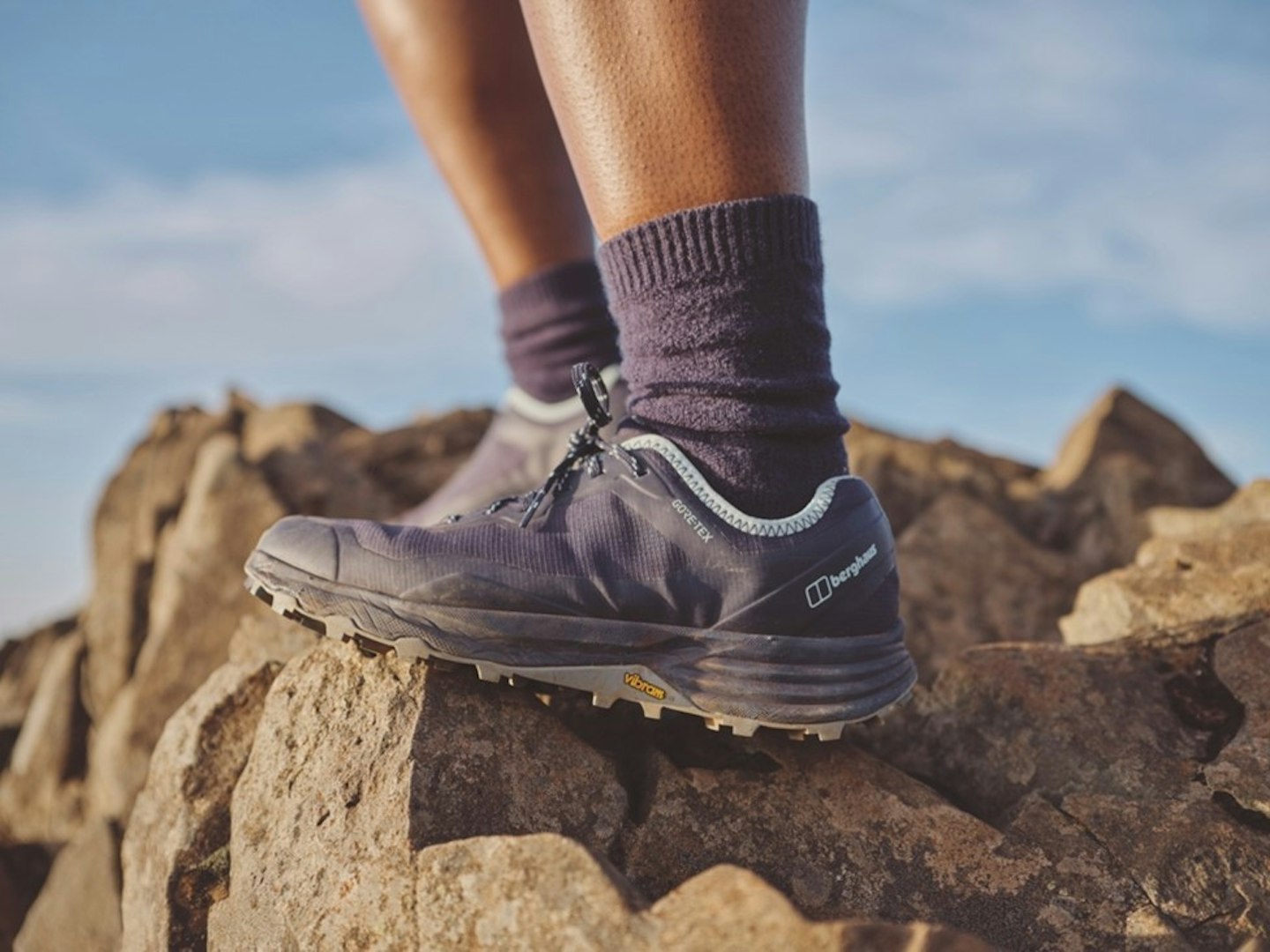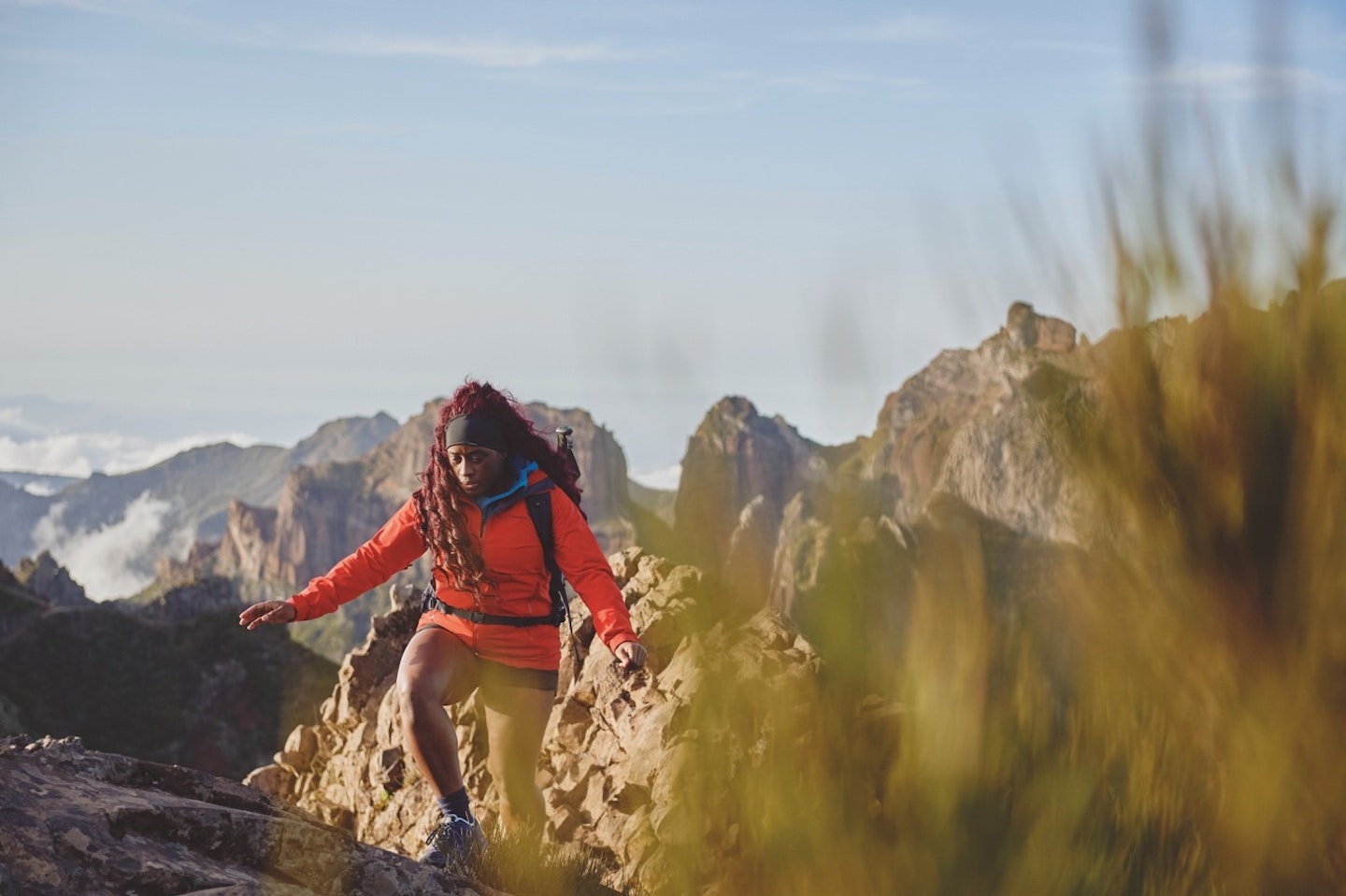Trail magazine teams up with Berghaus to look at the advantages of hiking shoes versus walking boots, and which footwear is best for your adventures.
Long gone are the days when footwear for walking meant heavy, stiff leather boots, and the only real choice you had to make was exactly what shade of brown you wanted them to be. These days there’s a vast array of options on offer, and while traditional leather boots still very much have their place, lots of different materials are now being used to make boots lighter and out-of-the-box comfortable without losing too much in the way of robustness.
Then there are shoes. Visit the Lake District or north Wales on a dry summer day and you’ll spot all kinds of footwear tramping up and down the well-constructed paths. And while we’re in no way suggesting that plimsols, high-heels or, God forbid, flip-flops are appropriate mountain-wear; the truth is that not all hiking routes demand your feet be clad in boots and a good pair of walking shoes may prove a suitable alternative.
But which should you choose? Boots or shoes? Well, only you and your feet can really make that decision, but here we look at 10 factors you might want to consider when mulling over the boots versus shoes debate…

Weight
It’s been said that ‘one pound on your feet equals five pounds on your back’, the suggestion being that even marginally lighter footwear can make your hiking far more comfortable. Despite even being attributed to Sir Edmund Hillary’s 1953 ascent of Everest, this equation does not hold up under scrutiny. However, it’s certainly true that lighter footwear can make for a less strenuous day on the trails and, simply because they contain less material, shoes inevitably are lighter than their boot alternatives. Of course, there are specialist lightweight hiking boots too, such as the classic Berghaus Supalite, which has been a favourite among gramme saving hikers for decades.
Cost
In the same way that having less material makes shoes lighter than boots, it also tends to make them less expensive. Some hiking footwear is available in both shoe and boot versions – such as the all-new Berghaus VC22 GTX range – and in these instances it is nearly always the case that the shoes are the lower-priced option - something to consider if you’re on a tight budget. Brands with a big collection of walking boots and shoes usually offer some great performance footwear at a wide range of prices. For example, the iconic BerghausHillmaster leather boot and lightweight Berghaus Expeditor Trek fabric boot are at different ends of the scale, and both are very popular with walkers.

Waterproofing
Both walking boots and hiking shoes are available with waterproof linings such as Gore-Tex in order to keep the wet on the outside of the footwear where it belongs. However, shoes have one major disadvantage when it comes to keeping feet dry. Due to their lower cut it’s much easier for water to get in over the top, so if you’re trekking somewhere potentially damp where bogs and river crossings will form part of the journey, boots may be a wiser choice.
Warmth
Depending on the season, you may have different requirements from your footwear in terms of how warm they are. In general, boots tend to be warmer. They cover more of the foot and insulated models are available for winter use. However, when it comes to shoes, there are far more options without waterproof linings, or using lighter weight materials, which adds breathability and helps keep feet cooler, so come the dry summer months, or when trekking abroad, these can feel more comfortable during extended use.

Comfort
Comfort is often described as simply a lack of discomfort. In other words, if your footwear is behaving as it should you probably won’t even notice it. Due to their lighter weight and tendency to be more flexible it might be easy to assume that shoes offer the most comfort. In the main, this is probably true, but there are occasions where boots offer the best defence against discomfort, the prime example being rocks in the shoe! Just as water can easily get over the top and into a shoe, dust, dirt, and gravel can do the same, and hiking with a pebble under your foot is the very definition of discomfort.
Support
With their higher cut and extra lacing, there can be no denying that boots offer far greater support to your ankles. If you’re a novice hiker tackling tough ground for the first time, have suffered an injury in the past, or just prefer to hit the trails safe in the knowledge that your ankles are being giving a little extra strength by your footwear, boots are the way to go. And there are options that hit the sweet spot of providing that extra support, without too much bulk. The new Berghaus VC22 Mid GTX has a higher cut than a shoe, delivering extra security and comfort, thanks to features like a knit collar at the ankle, all while keeping the weight low, so it won’t slow you down.

Protection
Along with increased support from higher cut boots comes increased protection. It’s much harder to knock your ankle on a rock or sting your lower leg on a nettle if its safely ensconced in a boot. Plus, any nasty biting critters have got to work harder to get at your skin, and that can only be a good thing!
Terrain
In reality, both the points above – support and protection, and how much of either you need – are determined by the terrain you’ll be on. If your hiking route is mostly well-built paths with only gentle ascent, then shoes are the way to go. But if you’re heading off path into the moors or mountains, where scrambling over boulders or wading through vegetation might be required, you’re better off with boots.

Versatility
If you’re lucky enough to be able to keep your walking footwear solely (no pun intended) for your hiking adventures, then this may not be of concern. However, the fact is that shoes tend to be more versatile when it comes to the occasions on which they can be worn than boots are. Heading into town shopping? You can wear hiking shoes for that. Popping to the pub? Shoes will look far more bar-ready than boots. Going for a bike ride? Again, you’ll probably be more comfortable in shoes. Of course, there’s nothing to say you can’t wear walking boots in these scenarios, but shoes will probably feel less conspicuous.
Compromise
Despite everything we’ve said, the line between boots and shoes is a thin, blurry one. You can find hiking shoes that offer the same chunky grip, robust build, and stiff flex as boots but in a lower cut. Similarly, you can find boots which are really just ankle-height shoes. And to confuse things still further, some models of footwear are available as either a low or mid version, making them difficult to pigeon-hole (like the Berghaus VC22 Mid GTX that we mentioned earlier). But actually, this is a good thing for us. It means that whatever it is we want from our footwear, whatever combination of comfort, protection, weatherproofing and support our hiking demands, there’s a shoe/boot/shoe-boot out there that will match it perfectly.

The new Trail range from Berghaus, which incorporates the VC22 GTX boots and shoes, delivers lightweight and packable kit for spring and summer adventures. This high-performing gear allows you to do more with less, so you can stay out longer and maximise your time in the mountains. See the full range at www.berghaus.com

